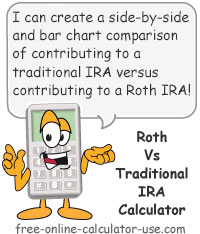IMPORTANT: Numeric entry fields must not contain dollar signs, percent signs, commas, spaces, etc. (only digits 0-9 and decimal points are allowed).
Click the Terms tab above for a more detailed description of each entry.
Step #1:
Enter the amount of your annual contribution to an IRA.
Step #2:
Enter your current age.
Step #3:
Enter the age you plan to retire at.
Step #4:
Enter the annual rate of return you expect to earn on your retirement savings.
Step #5:
Enter your current tax bracket percentage. A look-up table is included in the pop-up help (tap the info icon).
Step #6:
Enter the tax bracket percentage you expect to be in after retirement. A look-up table is included in the pop-up help (tap the info icon).
Step #7:
Tap the "Calculate IRA Comparison" button and scroll down to view the results.
Assumptions:
The Roth vs Traditional IRA Calculator assumes you won't make any withdrawals from your Roth IRA for at least 5-years and none before age 59-1/2.
The calculator also assumes your return on investment remains constant and that you will remain in the indicated federal tax bracket for each period.
Finally, the calculator does not account for any state taxes or AMT (Alternative Minimum Tax), nor does it attempt to qualify your contributions based on your income level.
All calculated results are hypothetical, so be sure to consult a qualified tax professional before deciding between a Roth and a Traditional IRA.


Follow me on any of the social media sites below and be among the first to get a sneak peek at the newest and coolest calculators that are being added or updated each month.